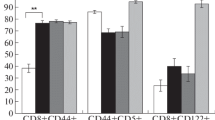Abstract
Spleen T lymphocytes from mice undergoing acute infection with lymphocytic choriomentingitis virus (LCM virus) were negatively selected by treatment with anti-Lyt or anti-L3T4 antibodies and complement. The subsets thus obtained were tested for their potential to lyse LCM virus-infected target cells in vitro and to confer on infected syngeneic recipients the ability to eliminate virus rapidly from their spleens. Both capacities were found to be associated with Lyt-1−2+, L3T4− cells. Previous studies had shown that LCM virus-specific cytotoxicity in vitro as well as reduction of replication of LCM virus in the adoptively immunized mouse requires compatibility at K and/or D of the major histocompatibility complex, and we conclude that clearance of LCM virus from the mouse's spleen is mediated by the subset of T lymphocytes that is functionally characterized as cytotoxic/suppressive.
Similar content being viewed by others
References
Brunner KT, Mauel J, Cerottini J-C, Chapuis B (1968) Quantitative assay of the lytic action of immune lymphoid cells on51Cr-labelled allogeneic target cellsin vitro; inhibition by isoantibody and by drugs. Immunology 14:181–196
Byrne JA, Oldstone MBA (1984) Biology of cloned cytotoxic T lymphocytes specific for lymphocytic choriomeningitis virus: clearance of virus in vivo. J Virol 51:682–686
Dialynas DP, Wilde DB, Marrack P, Pierres A, Wall KA, Havran W, Otten G, Loken MR, Pierres M, Kappler J, Fitch FW (1983) Characterization of the murine antigenic determinant, designated L3T4a, recognized by monoclonal antibody GK1.5: expression of L3T4a by functional T cell clones appears to correlate primarily with class II MHC antigen-reactivity. Immunol Rev 74:29–56
Julius MH, Simpson E, Herzenberg LA (1973) A rapid method for the isolation of functional thymus-derived murine lymphocytes. Eur J Immunol. 3:645–649
Kaufmann SHE, Simon MM, Hahn H (1979) Specific Lyt 123 T cells are involved in protection againstListeria monocytogenes and in delayed-type hypersensitivity to listerial antigens. J Exp Med 150:1033–1038
Ledbetter JA, Herzenberg LA (1979) Xenogeneic monoclonal antibodies to mouse lymphoid differentiation antigens. Immunol Rev 47:63–90
Lehmann-Grube F (1964) Lymphocytic choriomeningitis in the mouse. I. Growth in the brain. Arch Ges Virusforsch 14:344–350
Lehmann-Grube F, Ambrassat J (1977) A new method to detect lymphocytic choriomeningitis virus-specific antibody in human sera. J Gen Virol 37:85–92
Lehmann-Grube F, Assmann U, Löliger C, Moskophidis D, Löhler J (1985) Mechanism of recovery from acute virus infection. I. Role of T lymphocytes in the clearance of lymphocytic choriomeningitis virus from spleens of mice. J Immunol 134:608–615
Leung KN, Nash AA, Sia DY, Wildy P (1984) Clonal analysis of T-cell responses to herpes simplex virus: isolation, characterization and antiviral properties of an antigen-specific helper T-cell clone. Immunology 53:623–633
Lukacher AE, Braciale VL, Braciale TJ (1984) In vivo effector function of influenza virus-specific cytotoxic T lymphocyte clones is highly specific. J Exp Med 160:814–826
Mage M, Mathieson B, Sharrow S, McHugh L, Hämmerling U, Kanellopoulos-Langevin C, Brideau D, Thomas CA (1981) Preparative nonlytic separation of Lyt2+ and Lyt2− T lymphocytes, functional analyses of the separated cells and demonstration of synergy in graft-vs.-host reaction of Lyt2+ and Lyt2− cells. Eur J Immunol 11:228–235
Nash AA, Gell PGH (1983) Membrane phenotype of murine effector and suppressor T cells involved in delayed hypersensitivity and protective immunity to herpes simplex virus. Cell Immunol 75:348–355
Nash AA, Phelan J, Wildy P (1981) Cell-mediated immunity in herpes simplex virus-infected mice: H-2 mapping of the delayed-type hypersensitivity response and the antiviral T cell response. J Immunol 126:1260–1262
Rivers TM, Scott TFM (1936) Meningitis in man caused by a filterable virus. II. Identification of the etiological agent. J Exp Med 63:415–432
Shen F-W, Boyse EA, Cantor H (1975) Preparation and use of Ly antisera. Immunogenetics 2:591–595
Simon MM, Eichmann K (1980) T cell subsets participating in the generation of cytotoxic T cells. Springer Semin Immunopathol 3:39–62
Swain SL, Dialynas DP, Fitch FW, English M (1984) Monoclonal antibody to L3T4 blocks the function of T cells specific for class 2 major histocompatibility complex antigens. J Immunol 132:1118–1123
Varho M, Lehmann-Grube F, Simon MM (1981) Effector T lymphocytes in lymphocytic choriomeningitis virus-infected mice. Cytolytic activity of Lyt-23 spleen cells in vitro does not correlate with elimination of infectious virus from spleens. J Exp Med 153:992–997
Yap KL, Ada GL (1978) Cytotoxic T cells in the lungs of mice infected with an influenza A virus. Scand J Immunol 7:73–80
Yap KL, Ada GL, McKenzie IFC (1978) Transfer of specific cytotoxic T lymphocytes protects mice inoculated with influenza virus. Nature (Lond) 273:238–239
Yap KL, Braciale TJ, Ada GL (1979) Role of T-cell function in recovery from murine influenza infection. Cell Immunol 43:341–351
Zinkernagel RM, Doherty PC (1974) Restriction ofin vitro T cell-mediated cytotoxicity in lymphocytic choriomeningitis within a syngeneic or semiallogeneic system. Nature (Lond) 248:701–702
Zinkernagel RM, Welsh RM (1976) H-2 compatibility requirement for virus-specific T cell-mediated effector functions in vivo. I. Specificity of T cells conferring antiviral protection against lymphocytic choriomeningitis virus is associated with H-2K and H-2D. J Immunol 117:1495–1502
Author information
Authors and Affiliations
Rights and permissions
About this article
Cite this article
Assmann-Wischer, U., Simon, M.M. & Lehmann-Grube, F. Mechanism of recovery from acute virus infection. Med Microbiol Immunol 174, 249–256 (1985). https://doi.org/10.1007/BF02124809
Received:
Issue Date:
DOI: https://doi.org/10.1007/BF02124809




